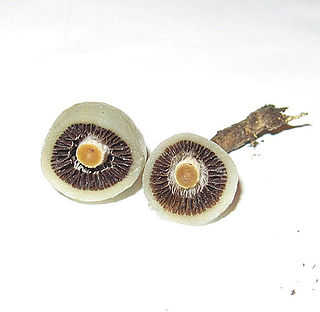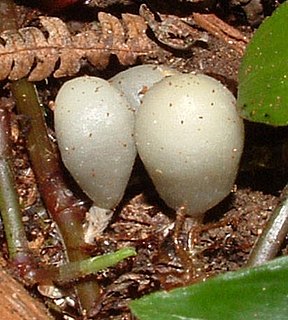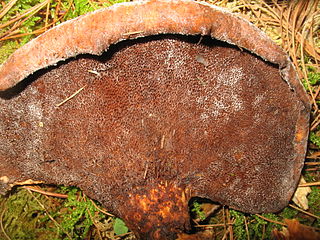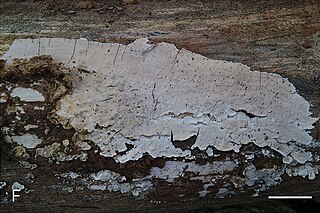Gordon Herriot Cunningham, CBE, FRS was the first New Zealand-based mycologist and plant pathologist. In 1936 he was appointed the first director of the DSIR Plant Diseases Division. Cunningham established the New Zealand Fungal Herbarium, and he published extensively on taxonomy of many fungal groups. He is regarded as the 'Father' of New Zealand mycology.

Hygrophorus is a genus of agarics in the family Hygrophoraceae. Called "woodwaxes" in the UK or "waxy caps" in North America, basidiocarps are typically fleshy, often with slimy caps and lamellae that are broadly attached to decurrent. All species are ground-dwelling and ectomycorrhizal and are typically found in woodland. Around 100 species are recognized worldwide. Fruit bodies of several species are considered edible and are sometimes offered for sale in local markets.

Antrodiella citrea is a bracket fungus native to Australia, and New Zealand.

Weraroa was a genus of mushrooms from the families Hymenogastraceae and Strophariaceae. The genus was initially described by mycologist Rolf Singer in 1958 to accommodate the single species Secotium novae-zelandiae reported by Gordon Herriott Cunningham in 1924. It was thought that the genus represented an intermediary evolutionary stage between a hypogeous (underground) ancestor and the related epigeous genus Stropharia. Advances in phylogenetics and taxonomic changes since 1958 found it contained unrelated species from multiple genera. It is now considered a synonym of the genus Psilocybe.

Psilocybe weraroa is a secotioid fungus in the family Hymenogastraceae. It is endemic to New Zealand. This species is closely related to Psilocybe cyanescens and is in both the section Cyanescens and the Cyanescens phylogenetic clade. As a bluing member of the genus Psilocybe it contains the psychoactive compounds psilocin and psilocybin.
Aleurocystis is a genus of fungi in the Stereaceae family. The widely distributed genus contains three species. Aleurocystis was circumscribed by the New Zealand-based mycologist Gordon Herriot Cunningham in 1956.
Abstoma is a genus of gasteroid fungi in the family Agaricaceae. The type species, A. purpureum, was described from New Zealand by mycologist Gordon Herriot Cunningham in 1926. Wright and colleagues transferred A. stuckertii to the genus in 1990, but Moreno et al. proposed a new combination Disciseda stuckertii in 2007. A. fimbrialis was described from Baja California, Mexico, in 1992. A. townei is found in western and southwest USA and in west Argentina, while A. reticulatum occurs in Australia and the western and southwestern USA.

Echinochaete is a genus of fungi in the family Polyporaceae. Circumscribed by English mycologist Derek Reid in 1963, the genus is widespread in tropical regions and contains five species.

Lopharia is a genus of fungi in the family Polyporaceae. The genus was circumscribed by Károly Kalchbrenner and Peter MacOwan in 1881.

Fomes hemitephrus is a bracket fungus in the family Polyporaceae. First named Polyporus hemitephrus by English naturalist Miles Joseph Berkeley in 1855, it was given its current name by the English mycologist Mordecai Cubitt Cooke in 1885. The species is found in Australia and New Zealand, and is one of the most common polypores in those countries, causing a white rot on several tree species.

Gyrophanopsis is a fungal genus in the family Meruliaceae. Circumscribed by Swiss mycologist Walter Jülich in 1979, the genus contains two species of crust fungi: the type, Gyrophanopsis zealandica, and G. polonensis, added to the genus in 1991.

Phallobata is a genus of fungi in the family Trappeaceae. The genus is monotypic, containing the single truffle-like species Phallobata alba, found in Australia.
Cunninghammyces is a genus of corticioid fungi in the family Cyphellaceae. The genus, described by Joost Stalpers in 1985, contains two species known from New Zealand and Réunion.
Palifer is a genus of corticioid fungi in the Schizoporaceae family. Circumscribed in 1991, the widely distributed genus contain four species.

Cortinarius porphyroideus, commonly known as purple pouch fungus, is a secotioid species of fungus found in Australia and in beech forests of New Zealand. It was one of six species that appeared as part of a series depicting native New Zealand fungi on stamps, released in 2002.

Sarcodon thwaitesii is a species of tooth fungus in the family Bankeraceae. It is found in Asia, Europe, and New Zealand, where it fruits on the ground in mixed forest.

Metuloidea is a genus of five species of fungi in the family Steccherinaceae. The genus was circumscribed by New Zealand-based mycologist Gordon Herriot Cunningham in 1965. The type species is M. tawa, a fungus originally described by Cunningham as a species of Trametes. Formerly classified in family Meruliaceae, Metuloidea was moved to the Steccherinaceae in 2016, following prior research that outlined a revised framework for the Steccherinaceae based on molecular phylogenetics.

Lopharia cinerascens is a species of crust fungus in the family Polyporaceae. It was first described by botanist Lewis David de Schweinitz in 1832 as Thelephora cinerascens. Gordon Herriot Cunningham transferred it to Lopharia in 1956. It is widely distributed in Africa, Asia, Australasia, and North America; it is less common in Europe and South America.

Clavogaster virescens is a species of secotioid or pouch-like fungus in the family Strophariaceae. It is endemic and indigenous to New Zealand, where it grows on rotting wood in native bush and mixed native and introduced forests. It has a stout yellowish stem, and a powder blue, purpleish or greenish blue cap that forms a pouch, often referred to as a peridium, enclosing reddish brown or orange chambered gleba. The species is sometimes knows as the "Spindle Pouch".













